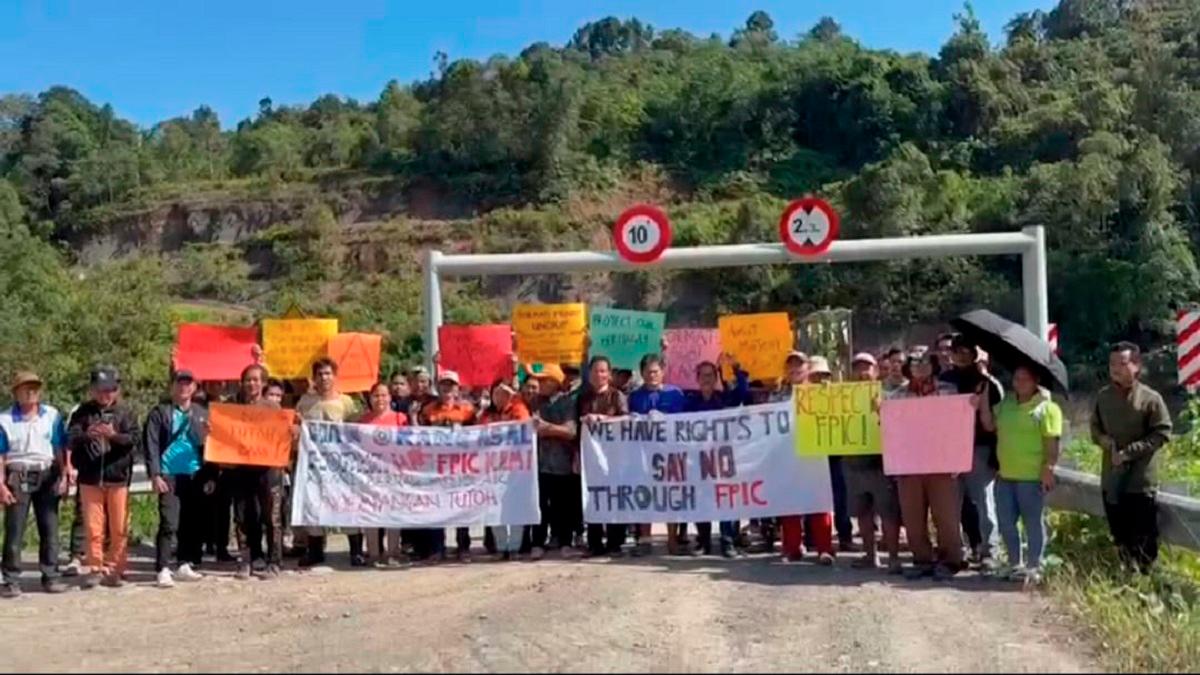BARAM: Indigenous communities throughout northern Sarawak have launched coordinated demonstrations today, mobilising across 29 settlements to oppose the state government’s planned cascading dam construction along the Tutoh river system.
The widespread protests have materialised simultaneously across multiple strategic locations including river crossings, bridge access points, and major transportation routes throughout the Baram district.
Affected communities participating in the demonstrations include residents from Long Latei, Long Kevok, Long Panai, Long Terawan, Long Bangan, and Long Pelutan.
Native rights advocate Willie Kajan confirmed that the coordinated resistance emerged following community receipt of official notifications regarding an imminent government ceremony to initiate ground preparation activities for the proposed Tutoh cascading dam project.
“The notification originated from the Sarawak Ministry of Public Utilities and Telecommunication, announcing plans for ritual blessings to commence ground preparation work for the Tutoh cascading dam construction.
“Our communities from 29 locations have organised today’s protests to demonstrate our unified opposition to this cascading dam initiative,“ Kajan stated.
The activist emphasised the environmental implications extending beyond immediate local impacts, warning that dam construction across the Tutoh River would trigger ecological destruction affecting not only the Baram district but also the Mulu National Park, which holds UNESCO World Heritage status.
These demonstrations represent the latest escalation in ongoing community resistance to Sarawak’s ambitious hydropower expansion plans. Previous organising efforts by the SAVE Rivers Network have gathered over 650 community signatures opposing the Tutoh-Apoh cascading dam proposal, while community representatives have challenged state officials to identify which local residents actually requested dam construction.
The protests come following Deputy Minister for Energy and Environment Sustainability Datuk Dr Hazland Abang Hipni’s August 14 announcement outlining plans for four new cascading dams, with two designated for construction in each of the Baram and Kapit districts.
These projects are scheduled to commence next year with targeted completion by 2030.
According to the deputy minister’s statement, these four facilities represent part of a broader initiative involving 12 new cascading dams planned for construction across Sarawak. The state currently operates four major hydroelectric installations: the Bakun Dam, Batang Ai Dam, Murum Dam, and Baleh Dam.
Community opposition has been building since Premier Tan Sri Abang Johari Openg’s confirmation of new hydroelectric dam construction, with indigenous groups expressing that they never provided consent for these developments.
Local communities have cited inadequate consultation processes and insufficient project disclosure as primary concerns driving their resistance.
The coordinated nature of today’s protests demonstrates significant organisational capacity among affected communities, reflecting years of experience gained through previous dam resistance campaigns.
Environmental advocates argue that cascading dam construction threatens traditional indigenous lifestyles while potentially compromising protected natural areas, including the internationally recognized Mulu National Park ecosystem.
These concerns reflect broader tensions between Sarawak’s renewable energy development objectives and indigenous land rights protection.
The state government’s hydropower expansion strategy aims to establish Sarawak as a regional clean energy hub, positioning the state to export renewable electricity to neighboring countries while supporting domestic industrial development.
However, these ambitions face mounting opposition from communities who argue their voices have been marginalised in development planning processes.
Today’s demonstrations signal that affected communities remain committed to sustained resistance against dam construction, potentially setting the stage for prolonged confrontation between state development priorities and indigenous rights advocacy.









